Ch 22: Prokaryotes
1/114
There's no tags or description
Looks like no tags are added yet.
Name | Mastery | Learn | Test | Matching | Spaced |
|---|
No study sessions yet.
115 Terms
background
first organisms on Eart ~3.5-3.8 BYA
millions of species (named or not), found everywhere
live on and in every other living organism
most benign & many essential to all life
ancient atmosphere
anoxic
only anaerobic organisms were able to live
autotrophic organisms that convert solar energy into chemical energy are phototrophs
photoprophs appeared within 1 billion years of the formation of Earth
cyanobacteria, evolved from these simple phototrophs at least 1 billions years later
ancestral cyanobacteria began “oxygenation” of the atmosphere
increase in O2 concentrations allowed the evolution of other life forms
anoxic
no molecular oxygen
what is cyanobacteria also known as?
blue-green algae
what did ancestral cyanobacteria begin of the atmosphere?
oxygenation
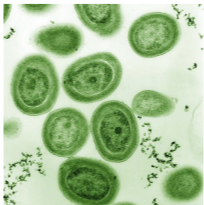
what is the most abundant photosynthetic organism on Earth?
marine cyanobacteria Prochlorococcus
extremophiles
bacteria and archaea that are adapted to grow under extreme conditions
acidophiles
pH 3 or below
alkaliphiles
pH 9 or above
thermophiles
temperature 60-80C (140-176F)
hyperthermophiles
temperature 80-122C (176-250F)
psychrophiles
temperature of -15-10C (5-50F) or lower
halophiles
salt concentration of at least 0.2 M
osmophiles
high sugar concentration
Deinococcus radiodurans
a prokaryote that can tolerate very high doses of ionizing radiation
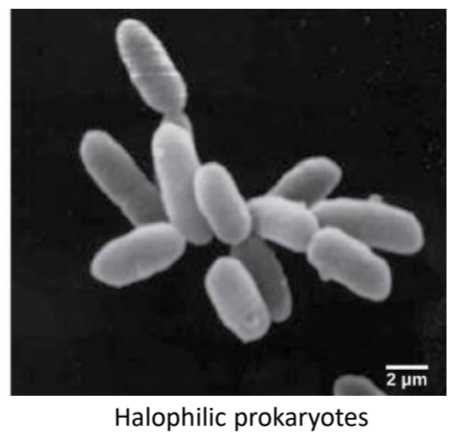
prokaryotes in the dead sea
it is a hypersaline basin that is 10x saltier w/ 40x more magnesium than sea water
in addition, they have divalent cations (Ca2+), are acidic, and have intense solar radiation (not an easy place to survive) - halophiles
2 mediums for growing prokaryotes in the lab
culture medium and pure culture
what is German phys
culture medium
contains all the nutrients needed by the target microorganism, can be liquid(broth) or solid
after an incubation time at the right temperature, there should be evidence of microbial growth in the culture medium
solid: agar - a solidifying agent extracted from seaweed
pure culture
a laboratory culture containing a single species of microorganism
blood agar plates
used to diagnose Streptococcus infections
incubation
to maintain the controlled environmental conditions necessary for supporting growth
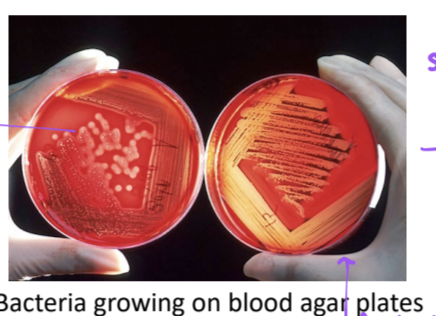
blood agar plates: destroyed red blood cells so surrounding media turns clear
left: non-hemolytic streptococcus
right: hemolytic streptococcus
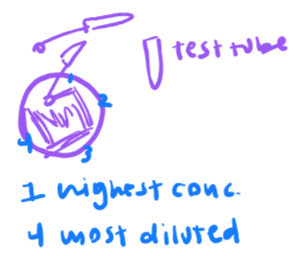
inoculation
process of introducing microorganisms into a culture media
1: highest concentration, 4: most diluted
what are prokaryotes growth limited to when growing in the lab?
food, moisture, crowding
how long does it take for one E. coli cell to divide?
20 minutes
how long does it take one E. coli cell to become 1 million?
6.7 hours, 20 divisions
colony
a visible mass of microorganisms originating from a single mother cell
prokaryotic cell size and structure
prokarytoic cells (0.1-5.0 um in diameter) are significantly smaller than eukaryotic cells (10-100 um in diameter)
the predominantly single-celled organisms of the domains Bacteria and Archaea are classified are prokaryotes
all cells have four common structures
the plasma membrane: functions as a barrier for the cell and separates the cell from its environment
the cytoplasm: a complex solution of organic molecules and salts inside the cell
a double-stranded DNA genome: the information archive of the cell
ribosomes: sties of protein synthesis
3 main shapes of prokaryotes
cocci
bacilli
spirilli
cocci
spherical or round
bacilli
rod-shaped
spirilli
spiral-shaped

diplococci
exist in pairs

tetrad
4 paired together
true or false. prokaryotes often occur in characteristic aggregates (pairs, chains, tetrads, clusters, etc.)
true
prokaryote structures
no membrane-bound organelles
no nucleus: DNA in nucleoid
ribosomes “free”
no microtubules
microtubules function
aid eukaryotes in cell division, movement, and mechanical support
capsule function
protective layer
pili function
attachment
flagellum function
movement
what 3 structures are not find in all prokaryotes
capsule
pili
flagellum
5 categories of proteobacteria
alpha
beta
gamma
delta
epsilon
what types of bacteria are gram -?
proteobacteria
chlamydias
spirochetes
cyanobacteria
proteobacteria
gram neg, diverse metabolism/nutrition
includes many N-fixing bacteria
includes common gastrointestinal pathogens (“food-poisoning”)
true or false. proteobacteria w N-fixing bacteria converts N2 to NH3, which becomes useful for plants
true
proteobacteria examples
escherichia coli - E. coli: normally beneficial, some strains cause disease
salmonella
Vibrio cholerae: causes cholera → severe diarrhea
what eukaryotic membrane is derived from proteobacteria?
mitochondria
chlamydias
gram neg, all are endoparasites (live w/ in animal cells)
chlamydias example
chlamydia in humans causes STD
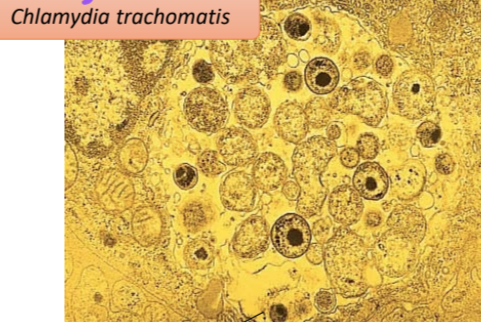
chalmydia trachomatis
causes eye infection (conjunctivitis) or pneumonia in children of infected women
causes pelvic inflammatory disease → infertility
preventable and curable
antibiotics are safe to use during pregnancy
spirochetes
spiral shape (spirrili)
many are free-living but include disease-causing pathogens
gram neg
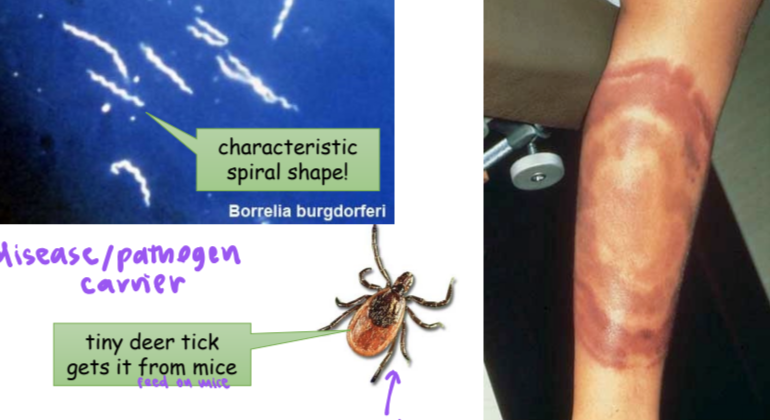
spriochetes examples
Treponema pallidum → syphilis (STD)
later stages: nerve and brain damage
Borrelia burgdorferi → Lyme disease
fever, rash, headache, fatigue
vector: tiny deer ticks which gets it from mice

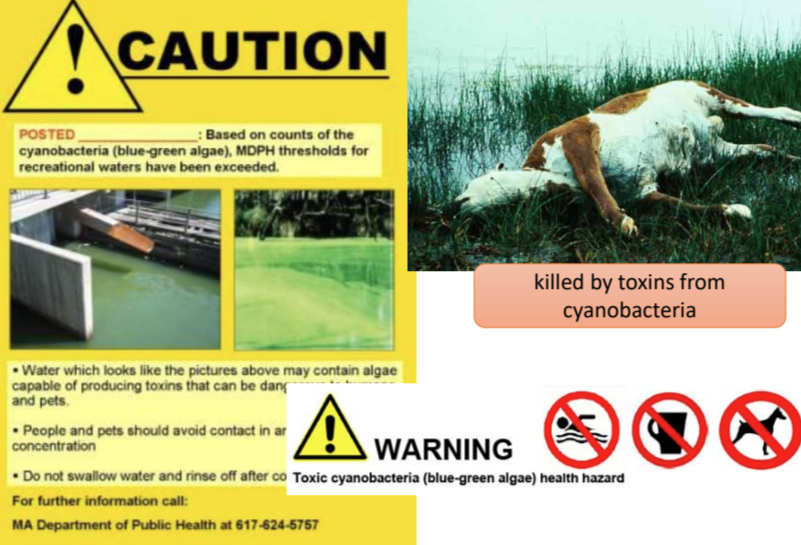
cyanobacteria
gram neg
plant-like, O2-generating photosynthesis (take in Co2)
some are also N-fixers
created living conditions
“blooms” can make toxins → make so much O2
hepatotoxins, neurotxins
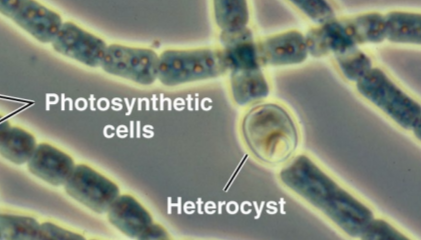
heterocysts
cells on cyanobacteria that are specialized N2 fixing cells
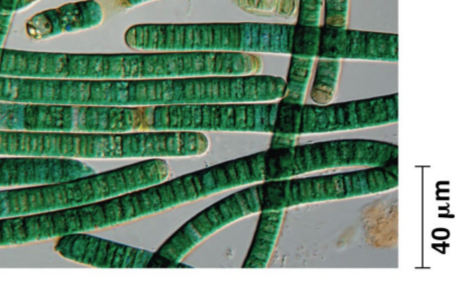
a filamentous cyanobacterium
Oscillatoria
gram-positive bacteria
include many decomposers in soils
include many pathogens
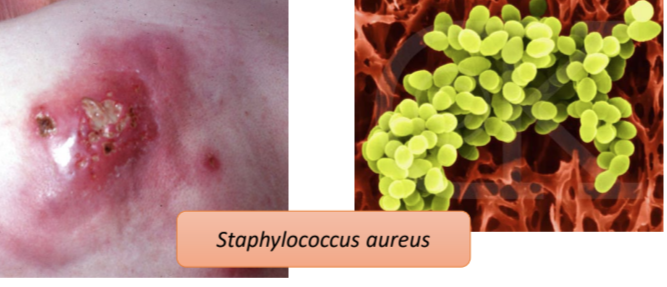
gram-positive bacteria examples
Bacillus anthracis → anthrax
Clostridium tetani → tetanus
streptococcus → strep throat
staph and MRSA infections
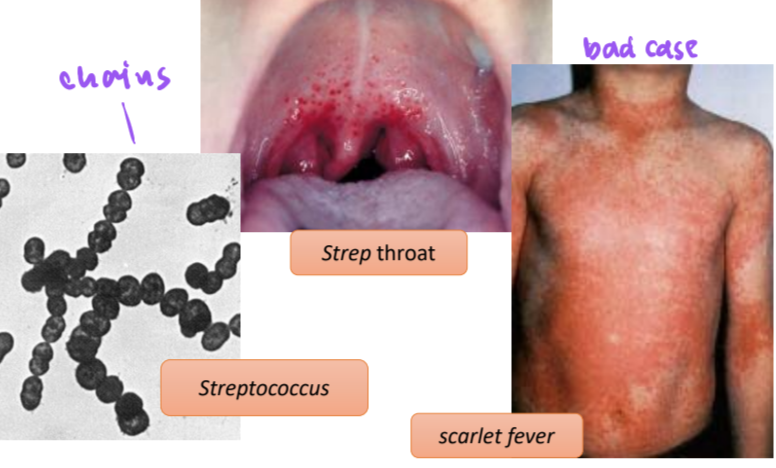
Domain Archaea
includes extremophiles and methanogens
but also many live in “normal” conditions
no human-disease causing archaeans!
what did chloroplasts derive from?
cyanobacteria
methanogenic archaea (methanogens)
produce methane (CH₄) as a byproduct of anaerobic respiration.
prokaryote structure
almost all have a cell well
lies outside plasma membrane
protects and prevents cell lysis
peptidoglycan?
bacteria: w / peptidoglycan (polysaccharides, sugars, and amino acids)
archaea: 2/ other structural polysaccharides (do not have peptidoglycan)
many have a capsule or slime layer
some have hair-like protein fimbriae
what is the difference between the bacteria and archaea cell wall
bacteria cell wall has peptidoglycan, archaea does not
prokaryotic plasma membrane
thin lipid bilayer (6-8 nm)
selectively permeable
phospholipid bilayer composed of 2 layers of lipids molecules
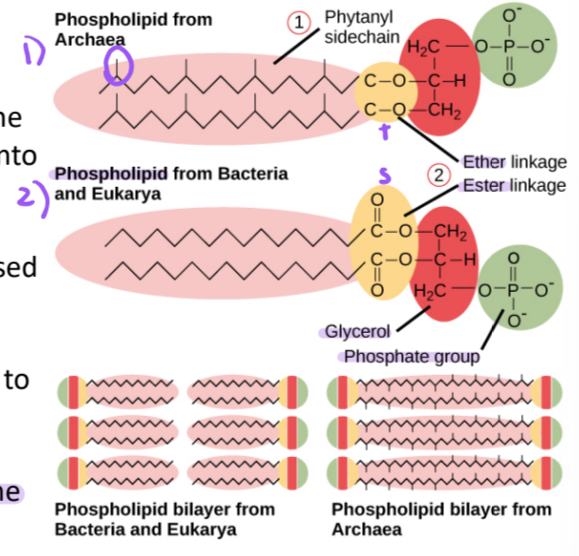
bacterial membrane
fatty acids linked to glycerol (like eukarya)
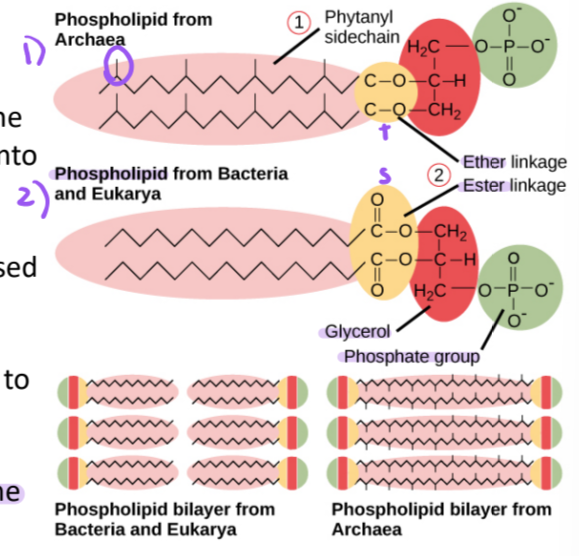
archaeal membrane
branched isoprene (phytanyl) chains linked to glycerol
true or false. a gram-stain reflects cell wall type
true
what color does a gram pos bacteria stain?
purple
who invented staining procedure?
Han Christian Grams in 1882
staining procedure
crystal violet stain: the primary stain in a gram stain is crystal violet, which binds to all bacterial cells. both gram pos and neg bacteria initially take up the crystal violet
iodine treatment: after, iodine is used as a mordant, which forms a complex w the dye. the complex is larger and harder to wash out the cell
decolorization w ethanol: ethanol is used as a decolorizer and causes the cell wall of gram neg bacteria to become more porous → crystal violet - iodine complex leaks out.
counterstaining w safranin: a counterstain (safranin) is applied, which stains any bacteria that were decolorized in the gram neg bacteria red or pink. b/c the gram pos bacteria retains the violet dye, they remain purple
in staining, why does crystal violet - iodine complex leak out of the gram neg bacteria but not the gram pos bacteria?
b/c gram pos bacteria have a thick layer of peptidoglycan in their cell walls, the wall retains the complex, unlike in gram neg bacteria
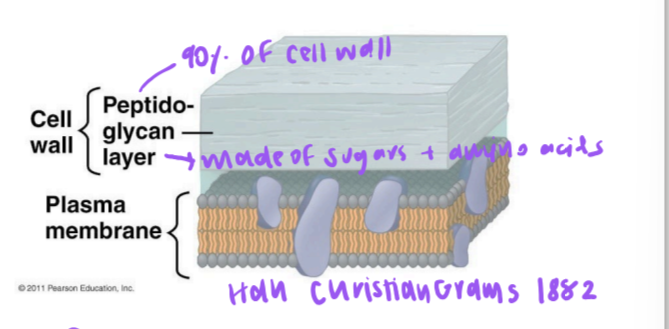
staining: gram positive bacteria
bacteria w/ thick peptidoglycan layer → stains purple in Gram stain
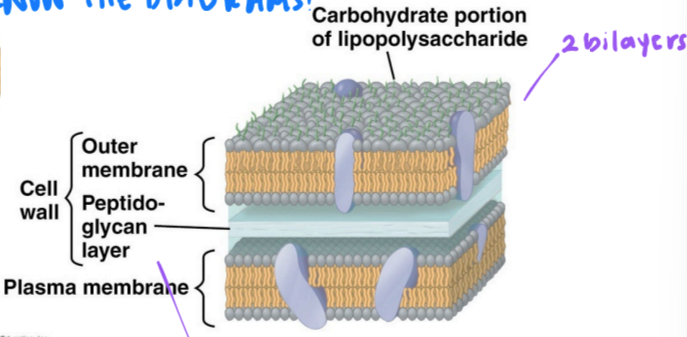
staining: gram negative bacteria
bactera w/ thinner peptidoglycan layer plus outer lipid bilayer membrane → stains pink in gram stain
outer lipopolysaccharide (LPS) layer often toxic, resists drugs and immune system
how much percentage does peptidoglycan make of the cell wall of a gram negative bacteria?
10%
how is a slime layer different from a capsule?
a slime layer is similar to a capsule but is loosely associated and easily washed off
many prokaryotes have a capsule or slime layer
sticky carbs and proteins secreted outside cell wall
adheres (glues) cells together or to surface
resists attack from immune system
holds in moisture
hydrophilic
prevents bacteria from dehydrating
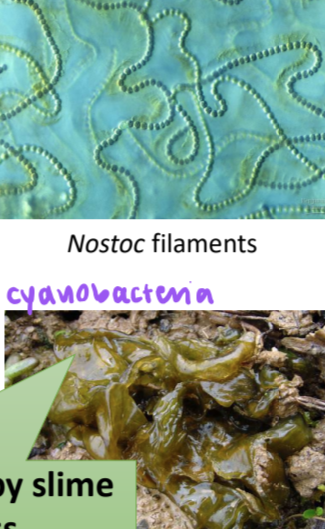
_______ filaments held together by slime make an easily visible mass
Nostoc (cyanobacteria)
true or false. flagellum, plural flagella, are hairlike structures that acts primarily as an organelle of the immune system.
false. these structures act primarily as an organelle of locomotion (motility)
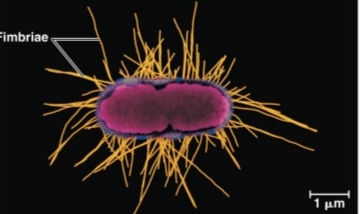
some prokaryotes have hair-like protein fimbriae
some also have short pili
help cells stick to surfaces and each other
many can form sex pilus (pl. pili) pulls two bacteria cells together for DNA transfer (conjugation)
forms mating bridge
short pili
originate in the plasma membrane
large and fewer in # than fimbriae
mainly in gram neg but sometimes in gram pos
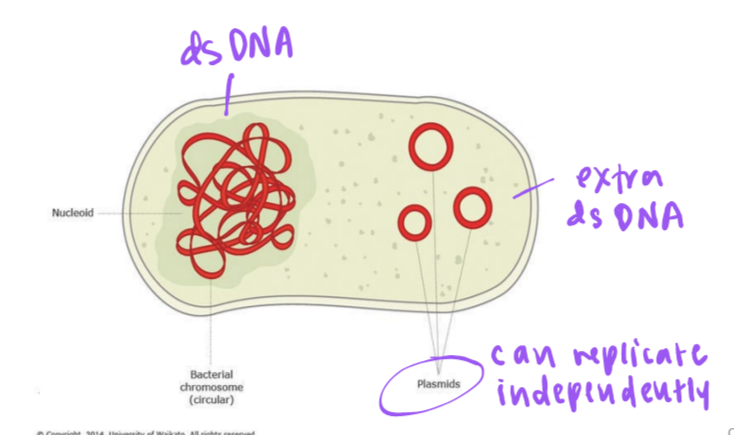
plasmids
many prokaryotes have plasmids:
extra tiny DNA rings w/ few genes
replicate independently
not “essential” for life, but add diversity
ex. drug resistance genes
true or false. plasmids cannot replicate independently.
false. plasmids can replicate independently
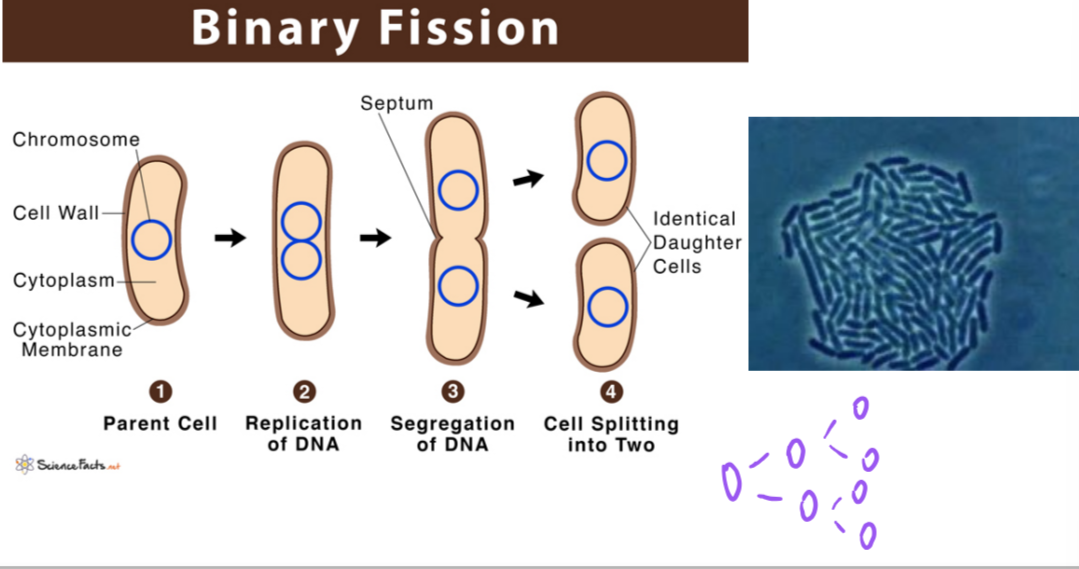
prokaryote reproduction
reproduction in prokaryotes is asexual
usually takes place by binary fission
binary fusion does not provide an opportunity for gentic recombination or genetic diversity
true or false. binary fission provides an opportunity for genetic recombination or genetic diversity.
false
prokaryotes can share genes by 3 mechanism
transformation
transduction
conjugation
prokaryote reproduction and genetic diversity
using transformation, transduction, and conjugation
high rate of cell division → many mutations
one mutation can change phenotype
mutations (except lethal ones) are passed on in clones
selection favors best clones
short generation times → rapid evolution
endospores
under stress, some bacteria produce endospores (dormant, non-reproductive)
endospores survive heat, drought for years
what are names of gram pos bacteria capable of producing endospores?
Bacillus anthracis → anthrax
Clostridium tetani → tetanus
photoautotrophs
use energy from sunlight, and carbon from carbon dioxide
chemoheterotrophs
obtain both energy and carbon from an organic chemical source
chemolithoautotrophs
obtain their energy from inorganic compounds, and they build their complex molecules from carbon dioxide
photoheterotrophs
obtain their energy from light, but their carbon from organic compounds
how to describe humans based on their use of carbon and energy sources?
chemo-organotrophs
phototrophs
use light as an energy source
chemotrophs
use chemical as their energy source
chemo-organotrophs
use organic chemicals as energy source
chemlithotrophs
use inorganic chemicals as energy source
autotrophs
use carbon dioxide as carbon source